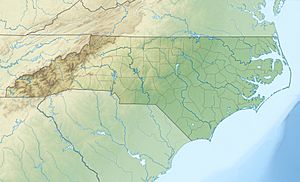Barkers Branch (Lanes Creek tributary) facts for kids
Quick facts for kids Barkers Branch |
|
|---|---|
|
Location of Barkers Branch mouth
|
|
| Other name(s) | Tributary to Lanes Creek |
| Country | United States |
| State | North Carolina |
| County | Union |
| Physical characteristics | |
| Main source | Cedar Branch divide about 0.25 miles northeast of Allens Crossroads, North Carolina 572 ft (174 m) 34°55′13″N 080°23′56″W / 34.92028°N 80.39889°W |
| River mouth | Lanes Creek about 2 miles north of Sturdivants Crossroads, North Carolina 418 ft (127 m) 34°55′51″N 080°20′07″W / 34.93083°N 80.33528°W |
| Length | 4.51 mi (7.26 km) |
| Basin features | |
| Progression | east and northeast |
| River system | Pee Dee River |
| Basin size | 2.76 square miles (7.1 km2) |
| Tributaries |
|
| Bridges | Ajars Road, Camden Road, Baron Greene Road, Tanner Road, Philadelphia Church Road, Landsford Road |
Barkers Branch is a small stream, about 4.51 miles (7.26 km) long, located in Union County, North Carolina. It's a "first-order" stream, which means it's one of the smallest streams that doesn't have other streams flowing into it. Barkers Branch eventually flows into Lanes Creek.
Contents
Where Barkers Branch Flows
Barkers Branch starts its journey about 0.25 miles (0.40 km) northeast of a place called Allens Crossroads in North Carolina.
The Stream's Path
From its start, Barkers Branch flows generally towards the northeast. Then, it makes a turn and flows east. It finally joins Lanes Creek about 2 miles (3.2 km) north of Sturdivants Crossroads, North Carolina.
The Barkers Branch Watershed
A watershed is like a big bowl where all the rain and snow that falls drains into a specific stream or river. The Barkers Branch watershed covers an area of about 2.76 square miles (7.15 square km).
What Makes Up the Watershed
- This area gets about 48.2 inches (122 cm) of rain each year.
- About 38% of the land in the Barkers Branch watershed is covered by forests. This means there are lots of trees!
- The "topographic wetness index" for this area is 434.32. This number helps scientists understand how wet the land is and how water moves across it.



